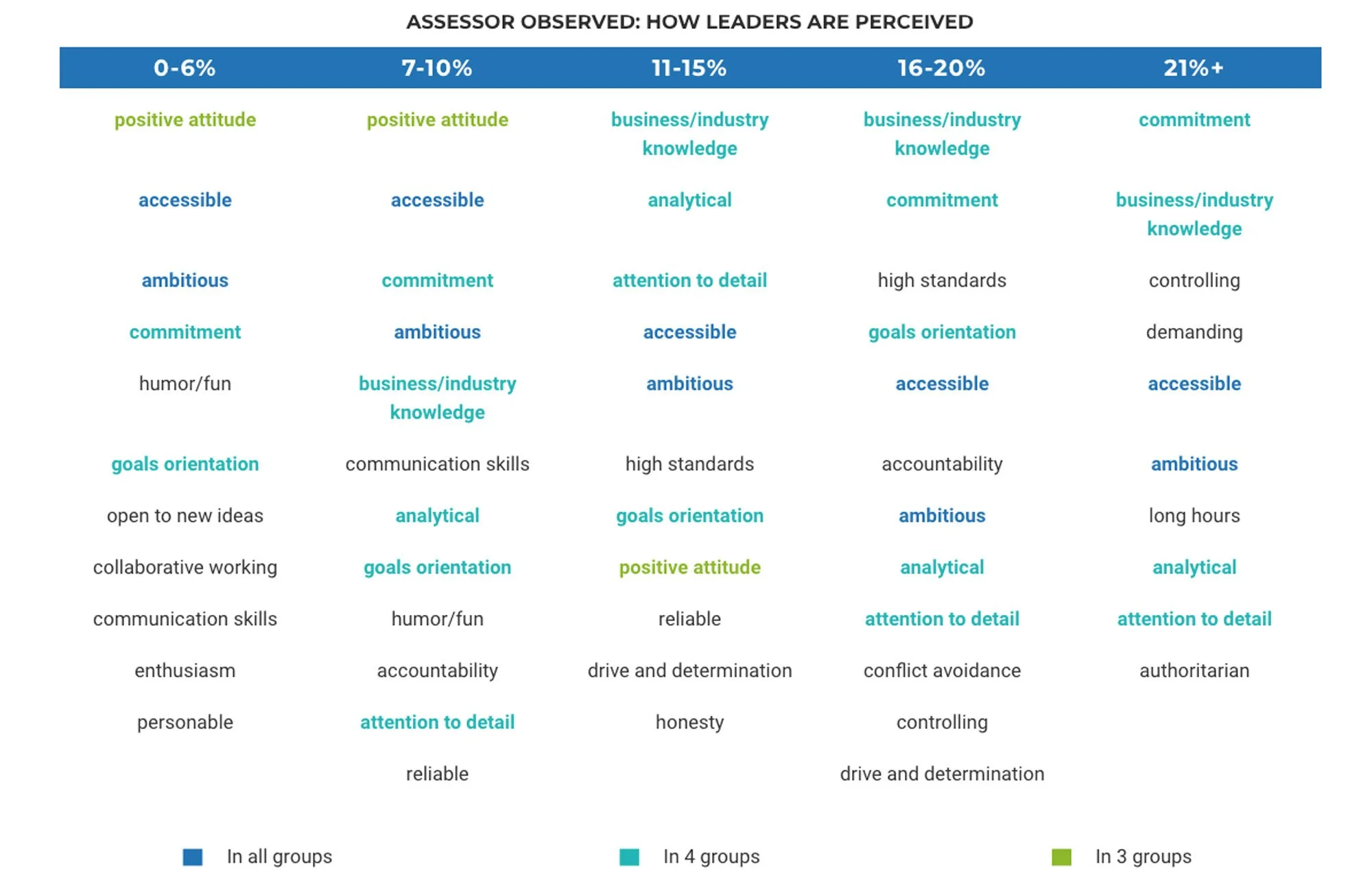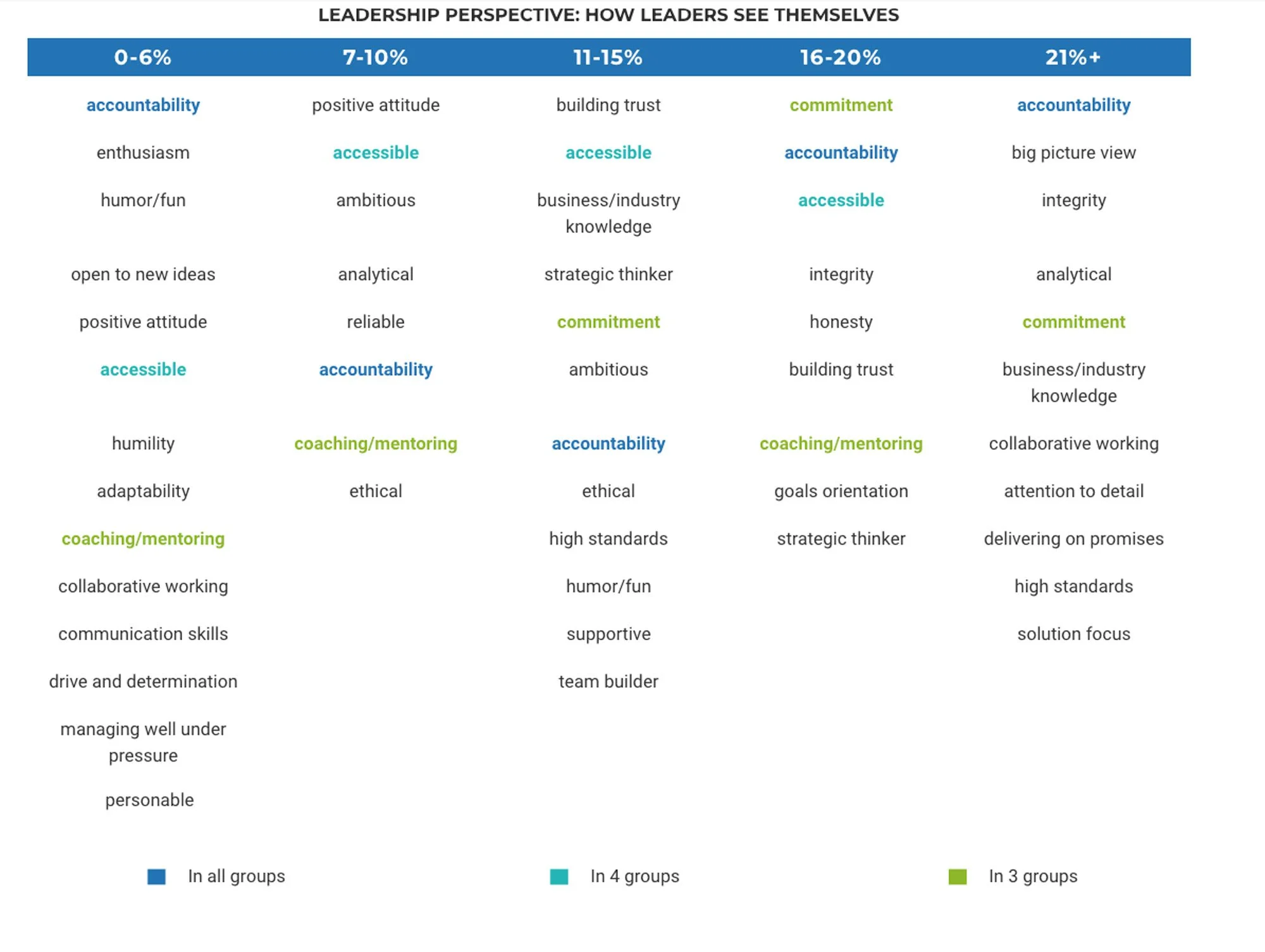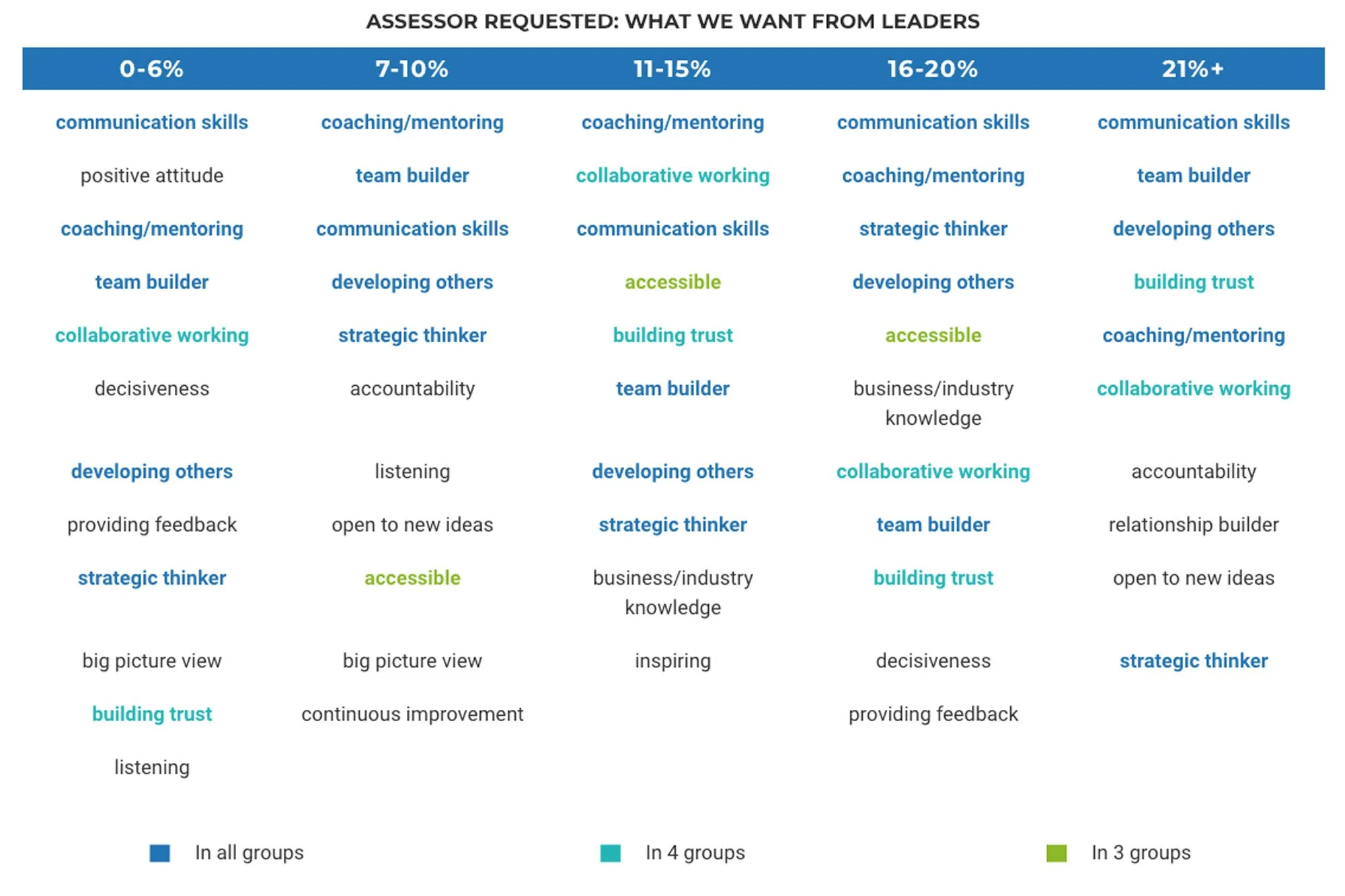Fearless Leaders: Examining the Impact of Personal Entropy on Leadership Style
Using data from Barrett Values Centre’s® Leadership Development Reports, a 360‐degree leadership development tool, we set out to investigate the differences among leaders based on their level of personal entropy. Personal entropy is the amount of fear-driven energy that a leader expresses in his or her day-to-day interactions. The lower the personal entropy, the fewer fears the leader brings into the workplace. High entropy leaders, on the other hand, let fear drive their decision-making.
In this paper, we will explore what all leaders have in common, what makes the leaders with the lowest entropy (fearless leaders) unique, and what employees want from their leaders.
Similar to a study conducted using the BVC’s Leadership Values Assessment, we found significant differences in style among leaders with low levels of personal entropy. Most notably, fearless leaders have a greater focus on their relationships with others, demonstrate values commonly attributed to successful leaders, and are more authentic in their interactions.
THE DATA
The data we used in this study includes the results from 128 Leadership Development Reports (LDR), covering 18 countries and 28 industries. The LDR compares a leader’s perception of his or her operating style with the perception of their superiors, peers, and subordinates (assessors). The results were divided into five personal entropy bands (0‐6%, 7‐10%, 11‐15%, 16‐20%, and 21% and over).
The data set included 68 male and 60 female leaders from Australia, Brazil, Canada, Colombia, Germany, Hungary, India, Italy, Netherlands, Russia, Saudi Arabia, South Africa, Sweden, Turkey, United Arab Emirates, UK, and USA. The industries included are Accountancy, Advertising & Marketing, Banking, Chemical & Pharmaceutical Manufacturing, Construction, Consultancy & Management, Education, Engineering, Financial Services, Food & Drink, Healthcare, Hotel & Restaurant, Insurance, IT & Computer, Local Government, Media-Film-News-TV-Publishing, Motor Vehicle Manufacturing, Non-Profit, Postal & Logistics, Real Estate, Retail, Service, Telecoms, Transportation, and Utilities.
UNDERSTANDING PERSONAL ENTROPY
Personal entropy is the amount of fear‐driven energy that a person expresses in his or her day‐to‐day interactions. Personal entropy is expressed through potentially limiting values found at Levels 1, 2, and 3 of the Barrett Leadership Model. Examples of such values include blame, bureaucracy, hierarchy, and power.
All fears stem from believing that we don’t have enough money, safety and/or territory to satisfy our need for survival; we don’t have enough love, friendship and/or connections to satisfy our need for meaningful relationships; or we do not have enough confidence, success and/or authority to satisfy our need for self‐esteem.
The personal entropy of leaders creates cultural entropy in organizations. Cultural Entropy® is the amount of energy in an organization that is consumed in unproductive work. It is a measure of the conflict, friction, and frustration that exists within an organization.
VALUES LEADERS SHARE
How Leaders Are Perceived
Based on the results of the study, we found that among the top values chosen by the leaders’ assessors, two values were consistent with all personal entropy bands: accessible and ambitious.
At its essence, the word accessible is defined as “the ability to be reached”. It is also often associated with being open, easy to talk to, and friendly. However, when accessible is coupled with potentially limiting values such as controlling, demanding, and authoritarian, it becomes a tool for high entropy leaders to gain power or recognition. They may be reachable simply because they spend much of their time micromanaging others.
“If you’re the kind of boss who lasers in on details, prefers to be cc’d on emails, and is rarely satisfied with your team’s work, then—there’s no kind way to say this—you’re a micromanager.”
It’s not surprising that ambitious shows up as a consistent leadership value given the hard work and dedication it takes to climb the ranks. However, ambition also has a shadow side, which may explain why it is recognized as an attribute of both low and high entropy leaders.
“Ambition by itself is neither positive nor negative. What you do with the drive, like all human drives, is what matters. As 18th century political theorist, Edmund Burke posited, ‘Ambition can creep as well as soar.’ If ambition causes you to cut corners ethics-wise so much so that you sacrifice integrity and values, then ambition can be destructive. Conversely, if you channel your ambition into fulfilling organizational goals that build a stronger and better company and do it in ways that help employees and customers then ambition is a positive.”
Four of the five entropy bands also shared the values of commitment, goals orientation, attention to detail, analytical, and business/industry knowledge.
HOW LEADERS SEE THEMSELVES
Based on the results of the study we found that most leaders, apart from those exhibiting the highest levels of entropy, characterized themselves as accessible, while only two groups (7-10% and 11-15%) recognized that they are ambitious.
Leadership Perspective: How Leaders See Themselves
All leaders across all entropy bands feel that they demonstrate accountability. However, this value is only observed by one group of assessors (16-20%), as shown in Figure 1.
WHAT MAKES LOW ENTROPY (FEARLESS) LEADERS DIFFERENT
From the perspective of employees, fearless leaders place more emphasis on building connections–they have a greater number of “relationship” type values. However, leaders in the higher entropy bands (11% or higher), focus less on relationship values and more on their personal qualities and contributions. At 16% entropy and higher, while some positive relationship values are observed, potentially limiting values such as conflict avoidance, controlling, and demanding are clearly undermining interpersonal connections.
Fearless leaders have most of their values concentrated at Level 5 – Authentic Leader, showing a focus on creating shared mission and meaning within their organizations. Additionally, these leaders are the only group who are recognized as paying attention to values at Level 6 – Mentor/Partner Leader, which shows attention to creating mutually beneficial partnerships. They also have the widest spread of positive values across the Barrett Leadership Model.
All the higher Entropy bands are primarily concentrated at Level 3 – Performance Manager, indicating an emphasis on systems, process, and achievement. As Cultural Entropy increases, leaders show there is a stronger concentration of values at the lower three levels of consciousness.
VALUES UNIQUE TO FEARLESS LEADERS
There are a number of values that fearless leaders exhibit that are not present in any of the other groups. In the top values chosen by their assessors, fearless leaders are seen to be personable and open to new ideas, while exhibiting collaborative working and enthusiasm.
These values seem to indicate that low entropy leaders foster an inclusive approach, something that is often attributed to great leadership.
Leadership isn’t about having all of the answers. “Successful leaders deflect attention away from themselves and encourage others to voice their opinions. They are experts at making others feel safe to speak-up and confidently share their perspectives and points of view.” The lowest entropy leaders understand this, as they are open to new ideas.
At the same time, leaders need to have a personality that makes it easy for others to approach them. It’s not just being likable. The value of personable recognized in the lowest entropy leaders also has business implications. “Being personable is a leadership strength, while being unapproachable, prickly or guarded shuts people up and shuts them down, cutting off information flow and collaboration vital for a team to do its best work.”
Just as leaders can’t be expected to know everything, they certainly can’t be expected to do everything. Collaborative working suggests that the lowest entropy leaders understand the importance of working with those around them to achieve goals. “Increasingly, work is being executed through networks of relationships that cross boundaries within and outside the organization. Leaders who excel at this capability demonstrate a talent for collaboration—a highly sought-after skill.”
If leaders aren’t excited about the mission and vision of the organization, how can others be? With their value of enthusiasm, leaders with the lowest entropy demonstrate the kind of passion that is necessary for attracting and motivating others to their cause. “Your employees want passion; in fact, they’ll go to the ends of earth because of it, live and die for it. Passion is such a key part of being a great leader that if you don’t have it, you simply can’t be a great leader.”
As we move away from the lowest entropy band, leaders tend to demonstrate qualities such as attention to detail, business/ industry knowledge, as well as being analytical. With the potentially limiting values of controlling, demanding, and authoritarian, those leaders with entropy over 20% appear to be largely stuck in serving their own self-interest, being hampered by fears and feeling unable to truly lead others.
AUTHENTIC LEADERSHIP
Fearless leaders, on average, have a much higher number of matching values between how they see themselves and how others see them compared to their high entropy counterparts.
A high number of matches shows that the leader is coming across effectively, authentically, and able to walk his/her talk.
“Our growing dissatisfaction with sleek, ersatz, airbrushed leadership is what makes authenticity such a desirable quality in today’s corporations—a quality that, unfortunately, is in short supply. Leaders and followers both associate authenticity with sincerity, honesty, and integrity. It’s the real thing—the attribute that uniquely defines great leaders.”
LEADERSHIP STRENGTHS
The Leadership Development Report asks leaders and assessors to rate the leader against a prescribed set of 26 ‘behaviors’ that our research has shown to be important for success. This data highlights the leader’s strengths and areas for improvement in relation to each of the levels in the Barrett Leadership Model.
When we look at the degree to which these behaviors are recognized among the leaders in the different entropy bands, fearless (low entropy) leaders’ strengths come across much stronger than those in the higher entropy bands.
The top-ranking behavior of fearless leaders has a strength rating of 89% while those in the 21%+ entropy group highest-ranking strength is 61%. A similar pattern emerges with the lowest ranking behaviors.
When we averaged the strength rating for all of the 26 behaviors, low entropy leaders’ average score is 44% compared to 20% for high entropy leaders.
We also noticed an interesting trend among leaders when we compared the entropy groups in regards to how they perceive their strengths, compared to how their assessors perceive their strengths.
Fearless leaders more often underestimate their strengths in the behaviors examined, while leaders with the highest entropy tend to overestimate their strengths. In 14 of the 26 behaviors, fearless leaders rated themselves lower than their assessors. High entropy leaders rated themselves higher than their assessors in 12 of the areas. This data seems to indicate that fearless leaders are more self-aware, humble, and honest about their strengths and limitations.
WHAT WE WANT FROM LEADERS
There are five values/behaviors important for leaders to reach their full potential. These are communication skills, coaching/mentoring, team builder, developing others, and strategic thinker. The first four of these values are “relationship” type values. Across all groups, the significant shift in emphasis requested is for leaders to become more people-focused, building connections, and support for others. They are asked to focus less on their own personal qualities and contributions and start instead to truly lead others.
Most leaders, except those in the 7-10% entropy band, are asked to focus on collaborative working and building trust; more focus again on “relationship” type values.
Fearless leaders already demonstrate the highly desirable values of collaborative working and communication skills according to their assessors.
The top area of focus across all groups is at Level 4 – Facilitator/Innovator, indicating that leaders need to pay attention to the development of new ideas and learning, enabling others to express themselves and take more accountability. Additionally, assessors across all groups want leaders to increase their role as a Mentor/Partner, with more focus requested at Level 6. This is a call for leaders to make a difference in the world, to help employees realize their potential and collaborate more, both internally and externally.
CONCLUSION
“Almost everyone, except perhaps for some of the most highly evolved people, operate with some level of personal entropy. The problem with personal entropy is that, if you don’t learn to master it, it becomes counterproductive to meeting your individual short, medium and long-term goals.” Additionally, personal entropy influences Cultural Entropy which negatively affects employee engagement and organizational performance.
While leaders with the lowest entropy aren’t completely fearless, they demonstrate a stronger degree of personal mastery. “You achieve personal mastery when you are able to successfully manage your emotions so that you become responsible for your own emotions and are no longer dependent on others to meet your survival, relationship, and self-esteem needs.”
Fearless leaders demonstrate values commonly associated with successful leadership traits. They also come across more authentically, operate from a wider spectrum of consciousness, and their strengths are more strongly recognized by others.
Regardless of the level of personal entropy, there is a strong call for all leaders to focus more on building relationships. Many people in a leadership role are actually ‘managing’ people and processes, rather than truly leading. In essence, the call for leaders is to act more as a guide, by leading through serving others.
Those leaders who have let go of their fears and who demonstrate low degrees of dysfunction are closest to achieving this aim. However, all groups have work to do on helping to develop and coach others, with leaders across all groups also being asked to focus on building strong teams and paying attention to strategy.







